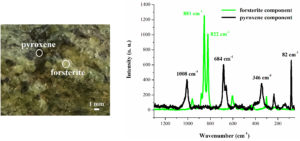
Using a Raman microscope, Highlands professors were able to see the two components of the rock peridotite – black pyroxene and greenish olivine.
July 7, 2021
This fall, New Mexico Highlands University will acquire a Raman microscope, giving students an opportunity to use cutting-edge technology.
The Raman microscope functions as both a microscope and a spectrometer, which means it can measure things at the micron scale and it can collect light waves to measure variation in physical characteristics across a spectrum. Microns are a millionth of a meter and about eight times smaller than a red blood cell. The information scientists get from using this technology allows them to understand the structure and properties of minerals and man-made materials. The Raman microscope can also be used to develop materials, such as semiconductors and pharmaceuticals.
Chemistry professors Arcadius Krivoshein and Tatiana Timofeeva, and natural resources professor Michael Petronis, were recently awarded a National Science Foundation grant of $150,000 that will go towards the specialized laser-based microscope. The microscope, which is used to perform Raman spectroscopy, is a relatively new technology that has been increasingly used by many industries over the past ten years—including pharmaceuticals, geology, forensic science, and quality control, among others.
The microscope will arrive on campus in September and will be available for classroom use as well as for students’ senior projects and theses.
“We’re still working with the manufacturer to optimize the configuration so that it’s easy for students to use,” Krivoshein said. “There are many options. It’s not just one instrument—it’s built for you, and you order what you need.”
As Krivoshein points out, Highlands is a small institution, so receiving a $150,000 grant for new technology provides important opportunities for students. “By using this instrument in class, we will give students a better opportunity to be more competitive in the job market,” said Krivoshein.
Raman spectrometers come in various sizes and use laser technology to probe materials, chemical compounds, and proteins/DNA. Handheld versions are increasingly used in forensics and police departments to identify gun residue or drugs, among other things. “It’s essentially the same instrument but loaded with different libraries, different software,” Krivoshein said.
The versatility of Raman microscopes makes it possible to examine the solubility of medications, for example, or the chemical fingerprint of crab meat, types of minerals in rocks, and components of a vaccine. Although the new microscope will be located in the chemistry department at Highlands, it will be available for use by professors and students in the biology and geology departments as well.
“Now everybody recognizes that Raman spectroscopy is not only used by physical chemists, it’s also used by many industries,” Krivoshein said. “We have a number of Highlands alumni who work either in the pharmaceutical industry or semiconductor industry, and this instrument will allow our graduates to continue to be successful in high-tech industries.”
